OPISYS orporated USHR-781921-5B 4G 5-Band Repeater Model Name-USHR-781921-5B User Manual revised
OPISYS Incorporated 4G 5-Band Repeater Model Name-USHR-781921-5B revised
User manual revised
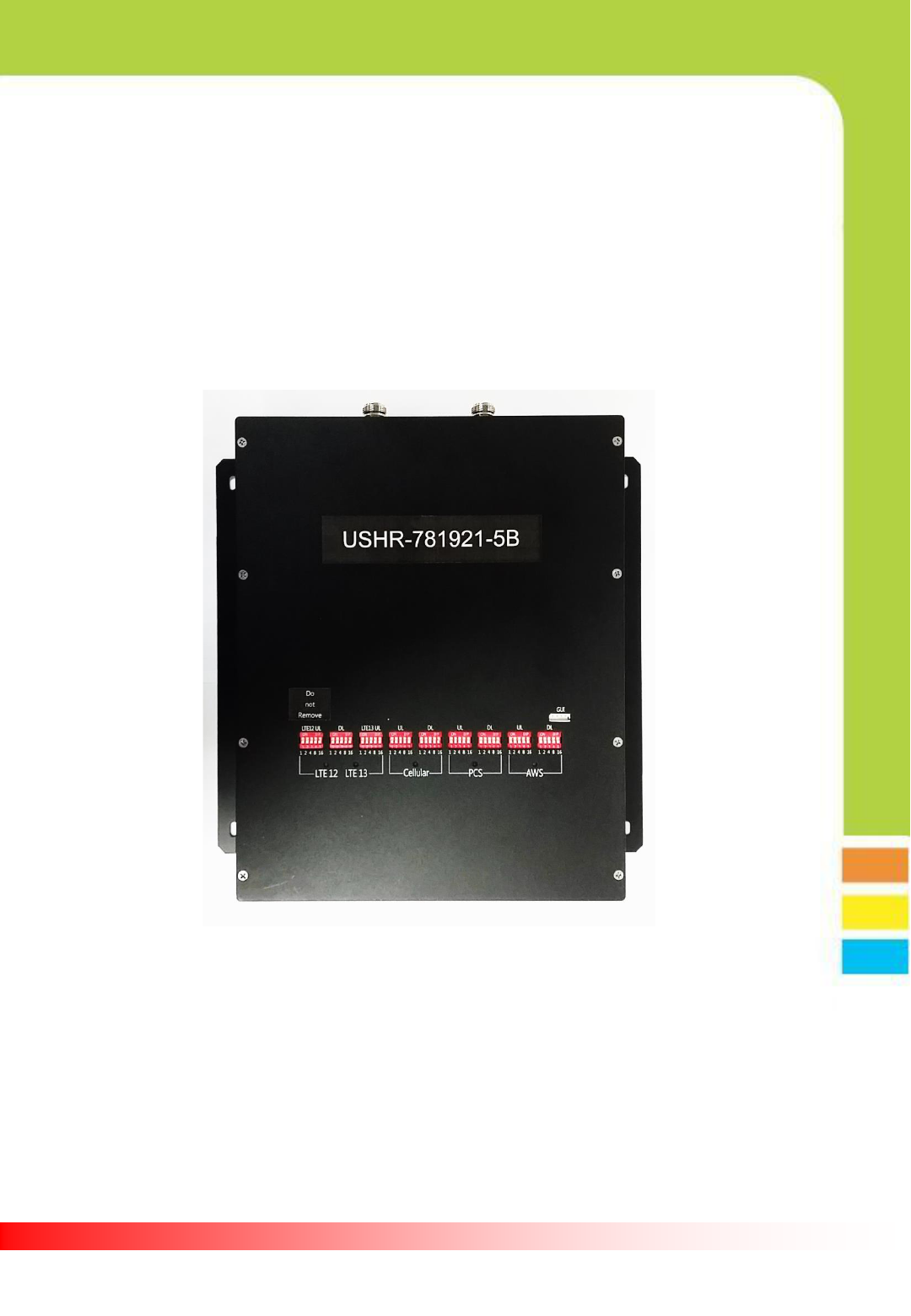
Five-band Signal Booster For In-building
Model : USHR-781921-5B
User Guide
&
Installation Manual
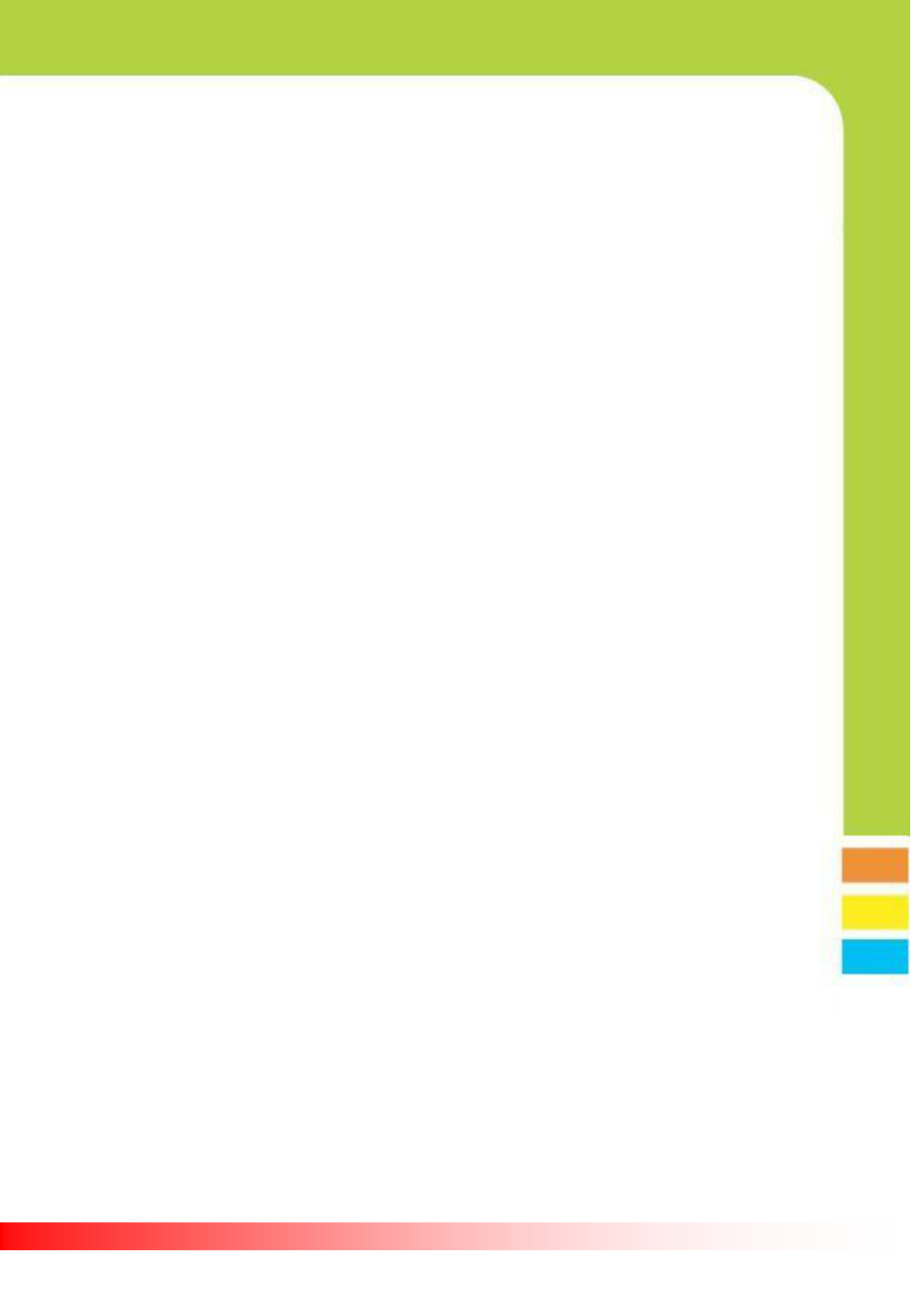
Five-band Signal Booster For In-building
Contents
1. Introduction
2. Kit Information
3. Installation
4. Troubleshooting
5. Specifications
6. Certificates
7. Contact Info.
- 2 -
Model: USHR-781921-5B
Leading Edge Technology Signal Booster
USHR-781921-5B signal booster designed to boosts cellular signal for area
prone to weak coverage area. Its coverage is on 800 MHz, 1900MHz, AWS and 4G
Verizon and AT&T 700 MHz as well as 4G Sprint. To allow installer to optimize
signal and gain control each frequency band, it has control knobs.
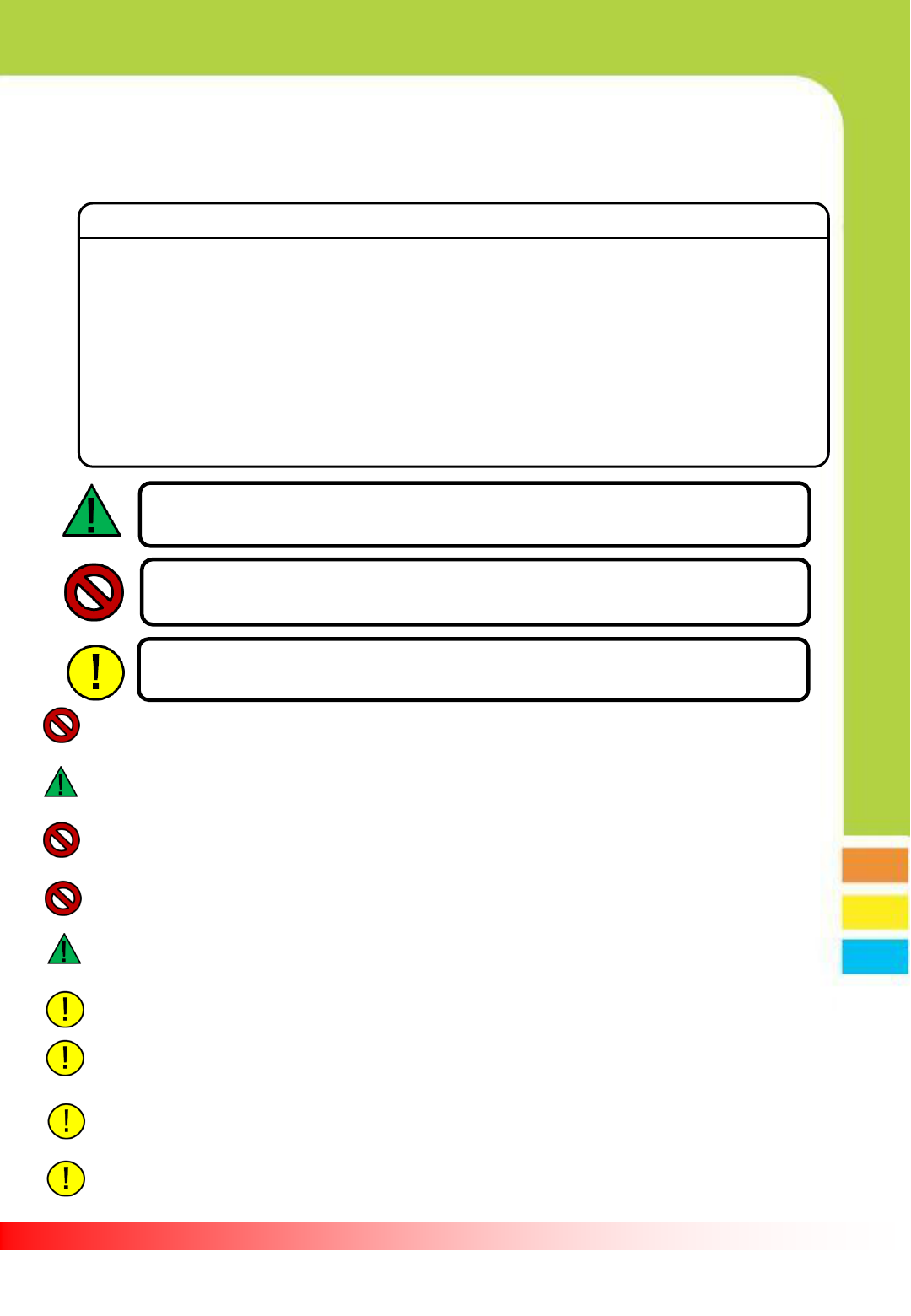
Five-band Signal Booster For In-building
1. INSTRODUCTION
1.1. Precautions
1.1.1 Do not drop the device
- It may damage the product and its function
1.1.2 Do not place near magnetic material
- It may cause possible malfunction
1.1.3 Product is recommended to be used with included AC/DC adapter
- It may cause possible malfunction
1.1.4 Install the product where it is recommended
- It may not properly operate if it is not recommended location
1.1.5 Do not disassemble/ repair the product
- Warranty may void once you disassemble the product.
1.1.6 Turn off the device immediately if a smoke or any strange odor is
detected from the product.
1.1.7 Use included bolts to install on the wall. Make sure it is safely
installed before operation
1.1.8 Outside Antenna must be installed no longer than 32 feet(10 meter)
above ground
1.1.9 This signal boosters are designed to be operated in a
designated area in a building.
Reference : Direction/Information for the proper operation
Cautions : Information for users to avoid malfunctions
Warning : Instruction for users to avoid unexpected hazard
- 3 -
This is a CONSUMER device.
BEFORE USE, you MUST REGISTER THIS DEVICE with your wireless provider and have
your provider’s consent. Most wireless providers consent to the use of signal boosters.
Some providers may not consent to the use of this device on their network. If you are
unsure, contact your provider. You MUST operate this device with approved antennas and
cables as specified by the manufacturer. Antennas MUST be installed at least 20cm (8
inches) from any person. You MUST cease operating this device immediately if requested
by the FCC or a licensed wireless service provider. WARNING. E911 location information
may not be provided or may be inaccurate for calls served by using this device.
This is a CONSUMER device.
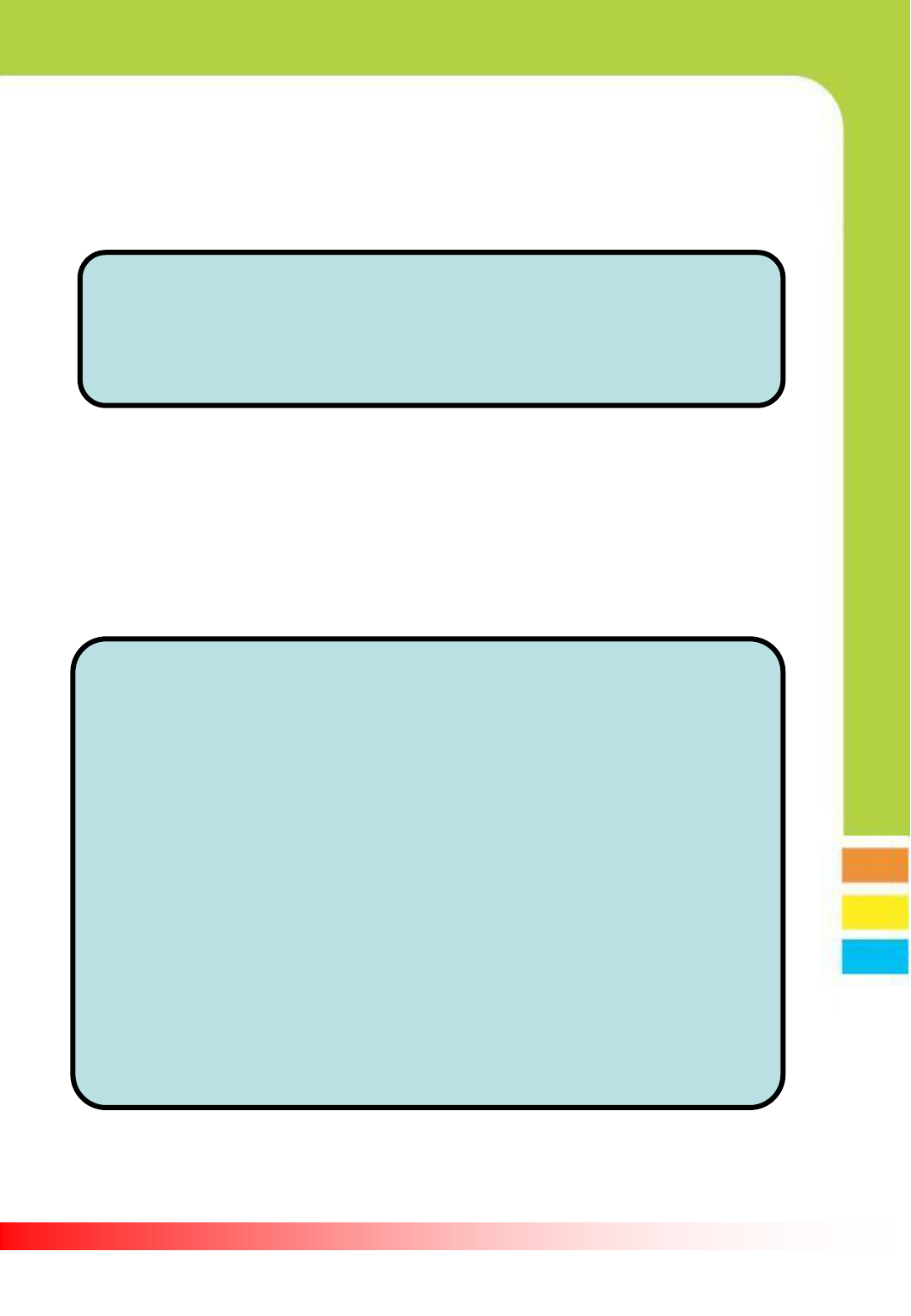
Five-band Signal Booster For In-building
1.2 . Summary & Features
1.2.1. Summary
This signal booster can be installed on residential area, office, warehouse etc. .
Following is advantages of using Five-band signal booster.
This Signal booster solves coverage problems and improves connection
quality in the building. In addition, this covers LTE of Band 12, Band 13,
Cellular Band 5, AWS Band 4 and PCS Band 25 for mobile phone users.
(Please see page 20 for operating frequency in details)
1.2.2. Features
I. Decrease dropped call rate
II. Increase signal strength
III. Improve Data / Voice quality
IV. Prolong hand phone battery life
V. Improve data Communication Rate
I. Wider Coverage area
- Band 12 Gain DL 60dB / UL 60dB
- Band 13 Gain DL 60dB / UL 61dB
- Band 5 Gain DL 62dB / UL 61dB
- Band 4 Gain DL 70dB / UL 68dB
- Band 25 Gain DL 69dB / UL 68dB
II. ALC(Automatic output Level Control)
- Stabilize operation in any radio environment
III. Fulfill revised FCC rule at +23dBm output power
- Provide high data communication rate
IV. Easy gain control by dip switch located on the front side of product
V. Support five band
- Enable to connect service from multiple carrier simultaneously
- Band 12/13/5/4/25 service simultaneously
- Band 12/13/5/4/25 adopt independent operation algorithm
- 4 -
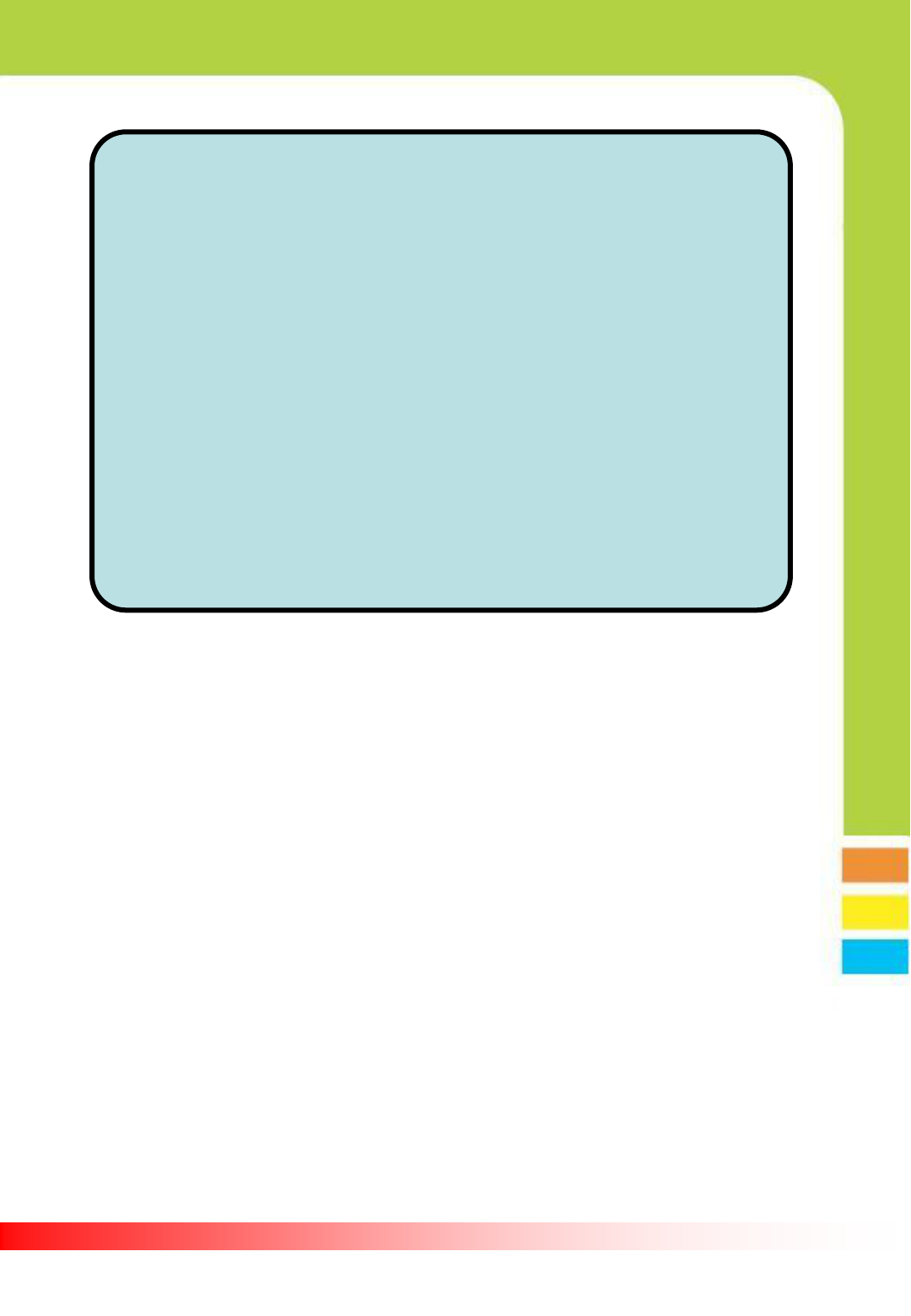
Five-band Signal Booster For In-building
VI. Check status of booster by LED indicator
VII. Allow to manage and control product by GUI(Graphic User
Interface)
- Please ask professional installer about GUI Program
VIII. Enable to stay connected in homes and offices
- Please ask professional installer for installation on homes &
offices
IX. Device status with LED light(see page 17)
X. Automatic isolation detection and gain setting
- If the device is shut down, turn on again after turning off the
AC power.
XI. Uplink sleep mode
- If no signal has been detected for 5 minutes, Uplink path will be
shut down.
XII. UL/DL gain interlocking mode
- 5 -
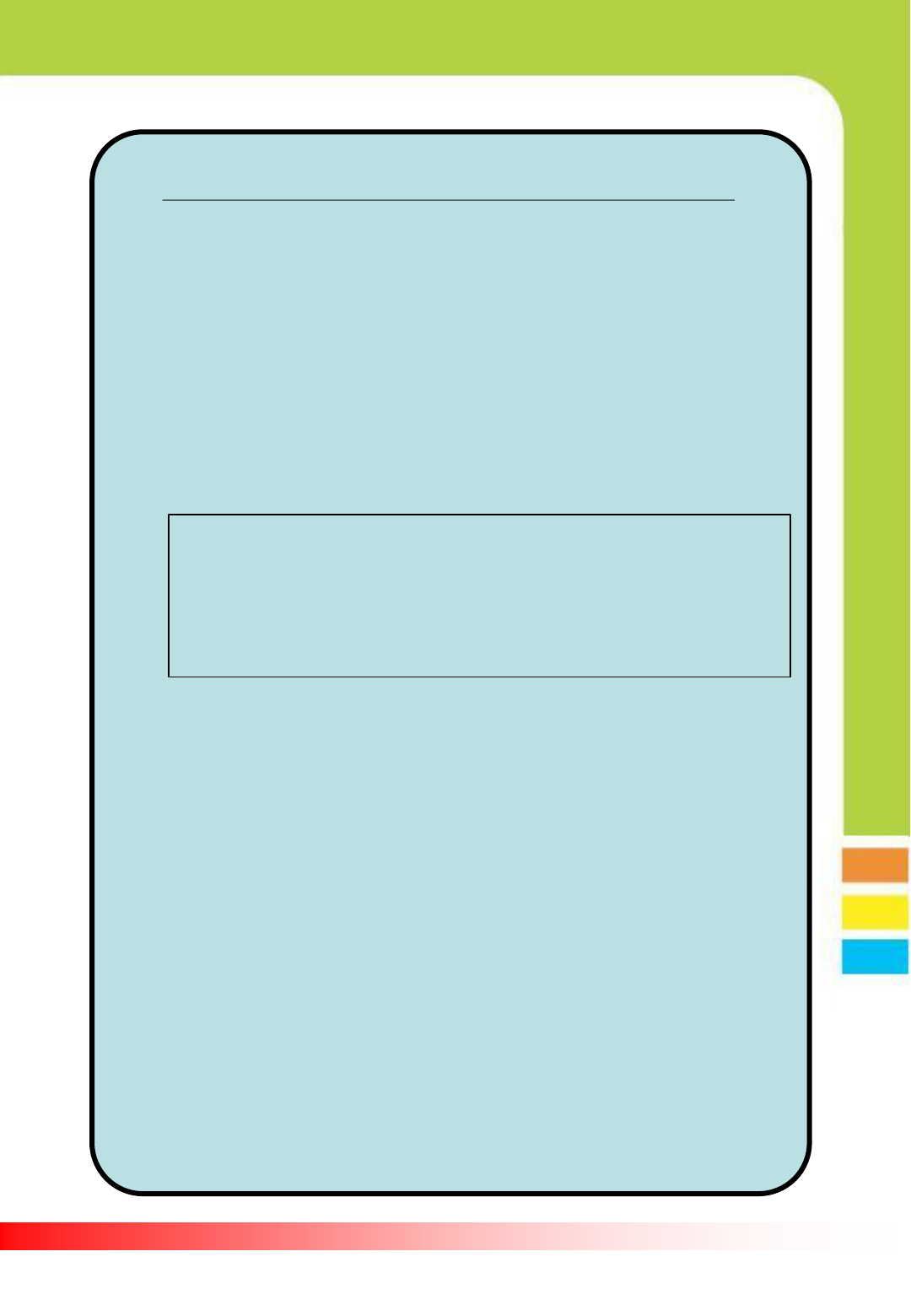
Five-band Signal Booster For In-building
1.3 Functions
I. Automatic Shut Down Mode
Built-In Automatic Self-Monitoring Features for Anti-Oscillation:
Automatic shut down mode operates when oscillation in the uplink and
downlinks bands are detected and terminates potential harmful interference to
wireless networks.
• 1 minute non-operative mode on the first initial oscillation detection.
• Default algorithm re-set mode as Auto S/D Mode is cleared
• Complete shut off mode on the 5th repetition of auto shutdown mode
status. All path are independently monitored and operated.
II. Intermodulation Gain & Power Limit Control
Uplink & downlink path formulates consistent link balance to regulate its
input and output gain & power limits.
Max UL gain < - 34dB – RSSI + MSCL (“ FCC 13-21,(i), 78p”)
RSSI : Downlink composite received signal power at the donor port
( calculation value : DL Output – DL Gain )
MSCL : Mobile station and repeater service port minimum coupling Loss
( setting value )
All path gain limits are independently controlled
III. ALC (Automatic Level Control) & AGC
ALC is implemented to keep regular output power level for abnormal high input
signal level.
The regular output power makes possible high quality of phone call and data
transfer.
AGC is designed to automatically control gain.
•Optimal Window Size (frequency range) sets the optimal level to increase
faster response to modulated signal level changes on the basis of gain
power control via signal input/output differential calculation all path gain
limits are independently controlled
IV. UL Path Automatic Sleep Mode
If coverage is non-existent (Zero Area Zone), Uplink path shuts off as
a
harmful interference avoidance
protocol and minimizes its power
consumption.
- 6 -
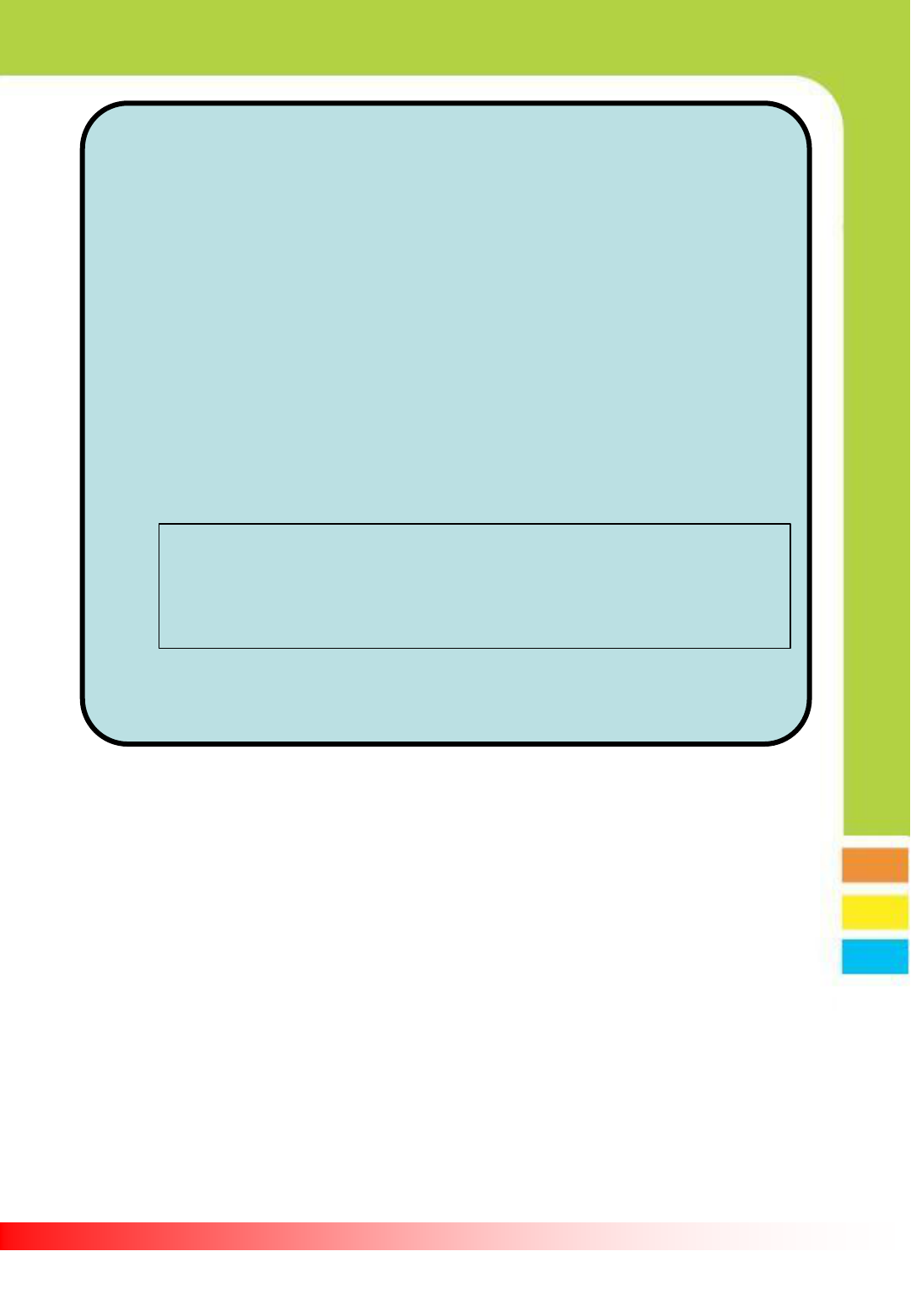
Five-band Signal Booster For In-building
IV. UL Path Automatic Sleep Mode (continue )
• Automatic Turn Off / if UL PATH < -90dBm
• Automatic Turn On / if UL PATH > -88dBm
**All path gain limits are independently controlled
V. Oscillation Auto Prevention
• Degradation Protection: Detects potential performance degradation
due to the overload signal feedback (over-heating) signals by isolation
check & gain configuration.
• Feedback Limits: Sets the operating range to exceeding high level
signals from donor antenna (outside antenna) of a signal booster to
service antenna (inside antenna)
Booster Gain < Antenna to Antenna Isolation – 15dB
If optimal isolation gain is not attained, Relevant path shuts off
automatically.
**All bands are independently controlled
- 7 -
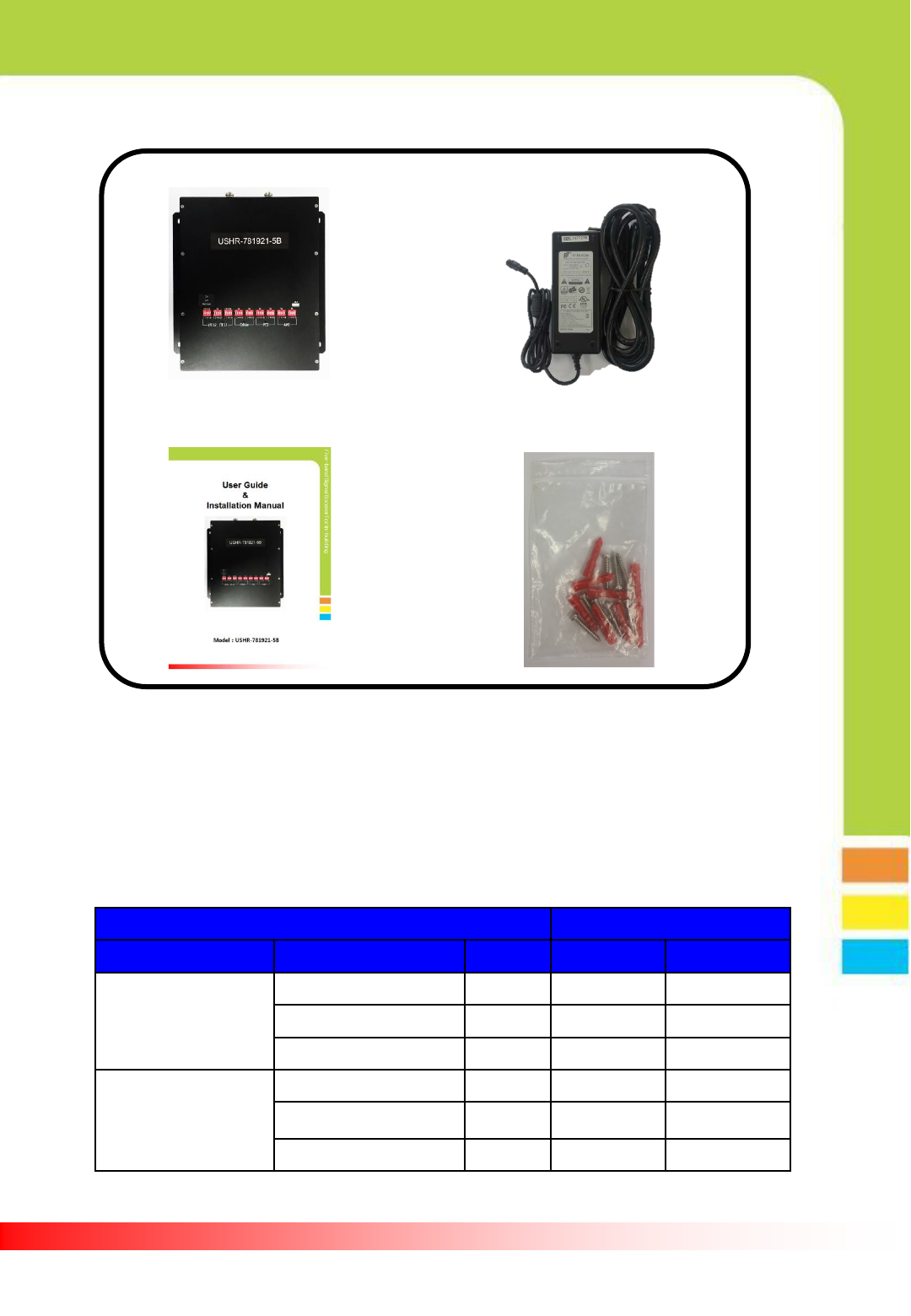
Five-band Signal Booster For In-building
① USHR-781921-5B ② AC/DC Adapter
③ User Guide
2. Kit Information
④ Installation bolts
① USHR-781921-5B : 5 Band BTS and mobile phone signal booster
② AC/DC Adaptor : 110VAC power supply
③ User Guide : Operation & Installation manual
④ Installation Bolts : Holds signal booster on the vertical wall
● List of approved antennas & cables
Antenna RF Cable
Item Model Gain Model Cable type
Service Antenna
(Indoor Antenna)
TS260771 +8dBi AC200000 LMR200
TS250374 +5dBi TS320000 RF240
TQI-700/2700-SJ-01 +2dBi TS340000 RF400
Donor Antenna
(Outdoor Antenna)
TS210471 +4.5dBi TS350000 ½”
TS220971 +9dBi TS360000 ½”
TDI-690/2500-SJ +7dBi - -
- 8 -
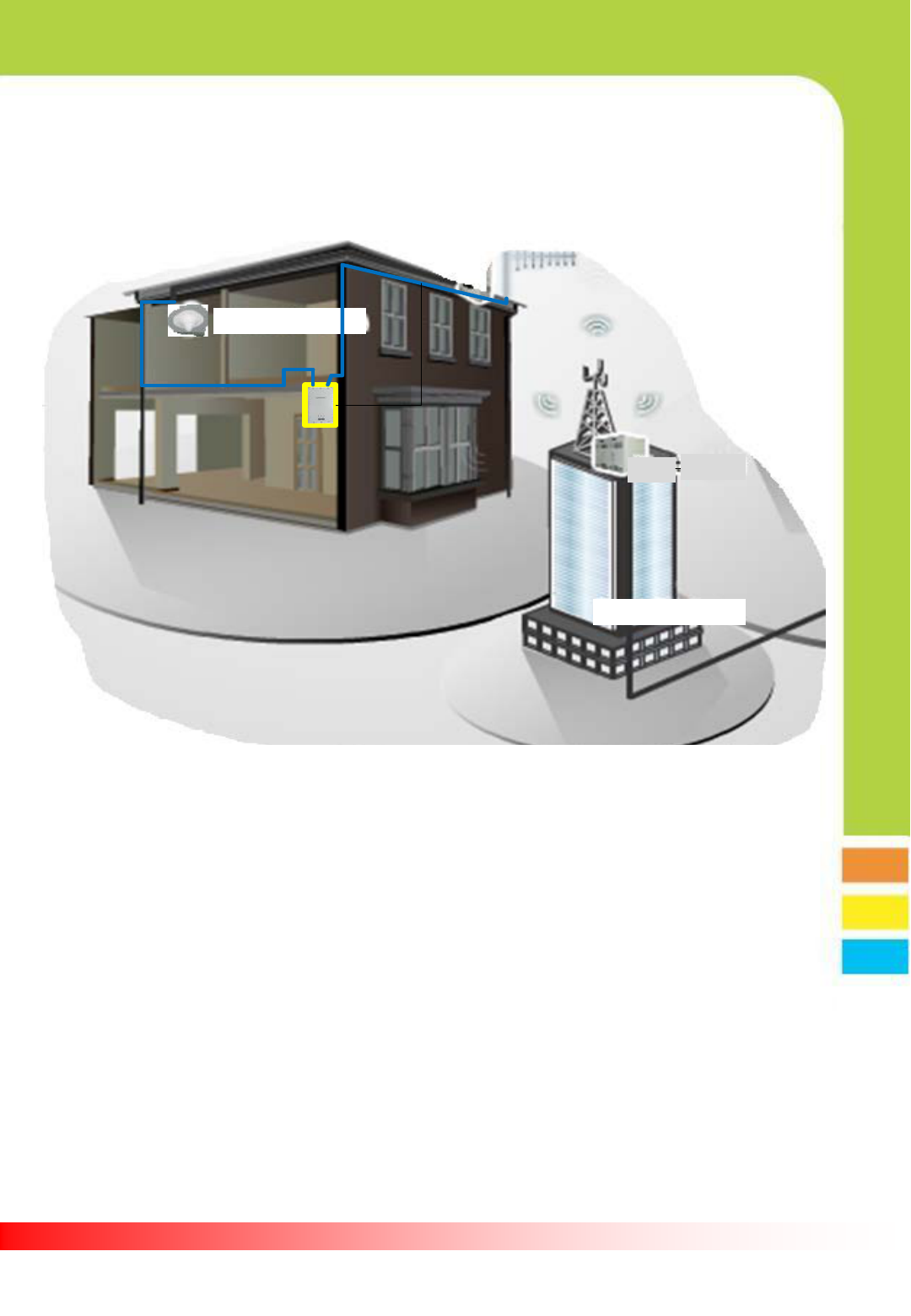
Five-band Signal Booster For In-building
3.1.1. Install outdoor antenna on higher location to avoid any signal interference.
Mount towards to the BTS where a clear line-of-sight path exists for optimal
signal level.
3.1.2. Install indoor antenna at appropriate location such as wall or roof ceiling.
Make sure service antenna is not blocked by furniture or appliances.
3.1.3. Use enclosed bolt to fix a booster on the wall and plug in power adaptor.
3.1.4. For best optimal operation, antenna isolation (oscillation level) should be
set above minimum 15 dB gain. The industry standard for antenna to antenna
isolation formula is BDA gain + 15 dB.
3. Installation
3.1 Installation Diagram
USHR-781921-5B
- 9 -
Indoor Antenna
Out Door Antenna
Base satation
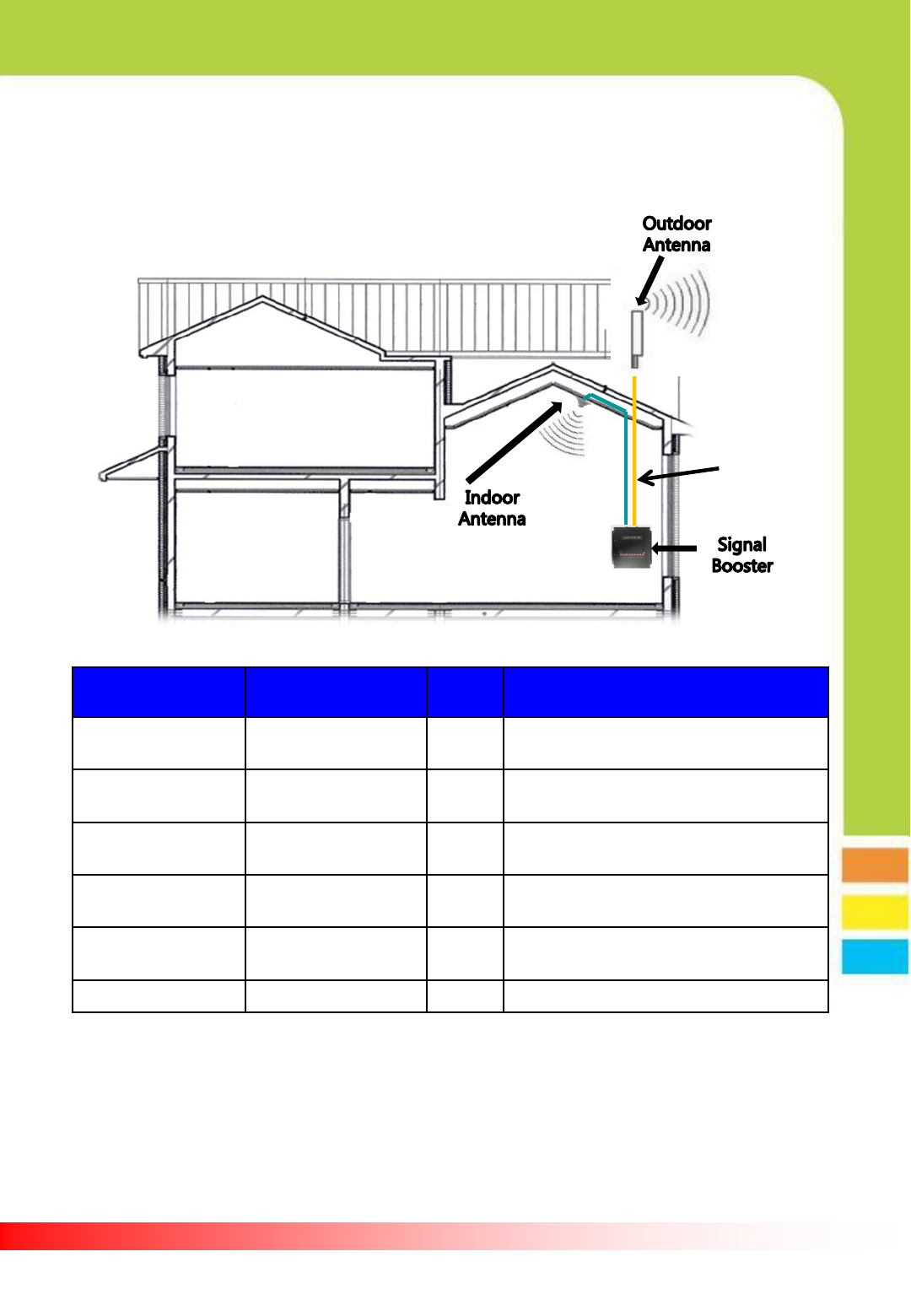
Five-band Signal Booster For In-building
3.2 One Outdoor Antenna & One Indoor Antenna Installation
Item Model Q’ty Instruction
Outdoor Antenna TS220971 1 Install toward to cell tower
Waterproof connectors connection
Indoor Antenna TS260771 1 Install indoor antenna opposite
direction to outdoor antenna
Signal Booster USHR-781921-5B 1 Install on hard wall with bracket and
screws
Outdoor Cable TS350000 1 Fasten connection between antenna
and cable connector
Indoor Cable TS320000 1 Fasten connection between antenna
and cable connector
AC/DC Adaptor SAMA-02-600 1 Use only provided adaptor
- 10 -
Cable
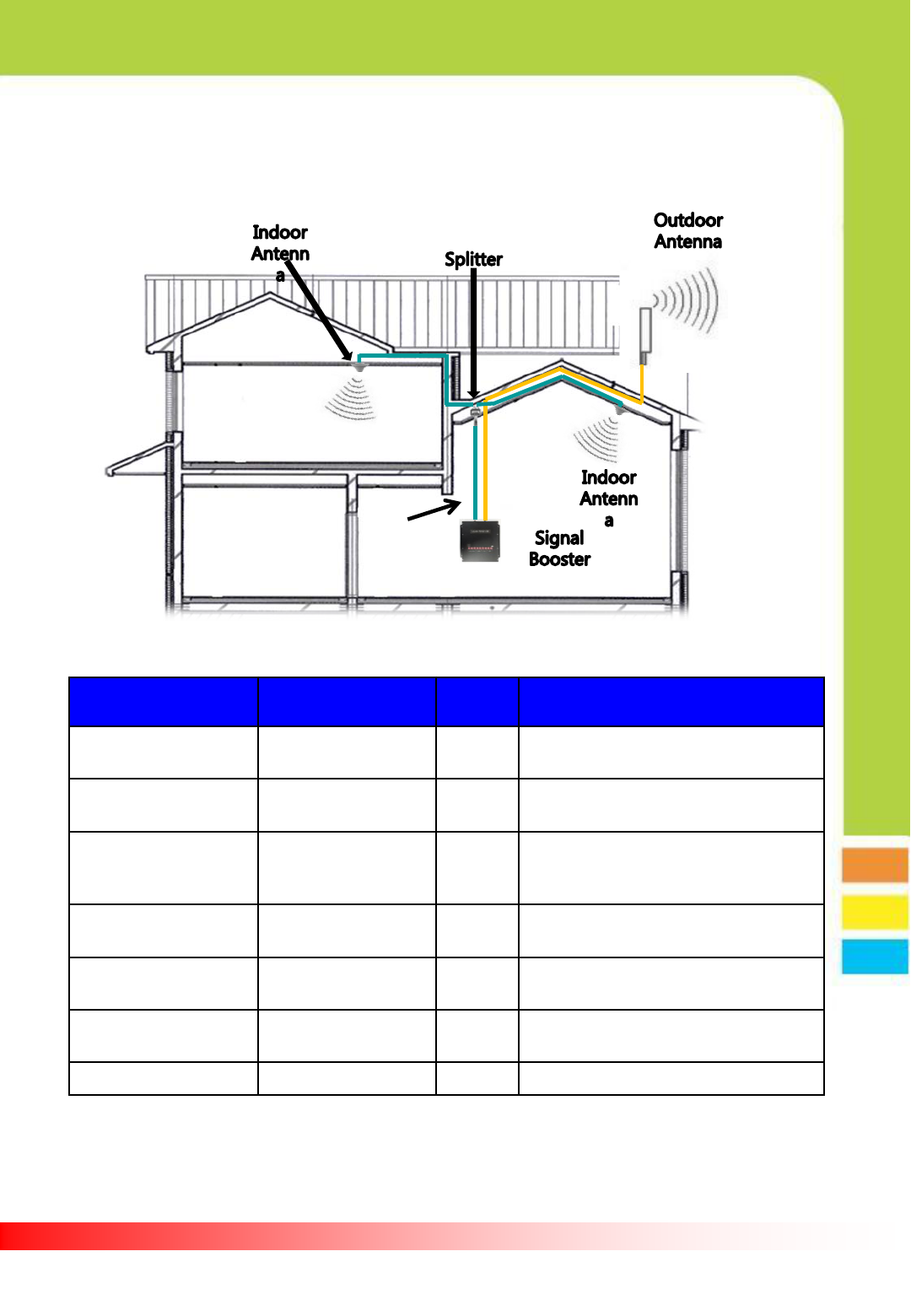
Five-band Signal Booster For In-building
3.3 One Outdoor Antenna & Two and More Indoor
Antenna Installation
Item Model Q’ty Instruction
Outdoor Antenna TS220971 1 Install toward to cell tower
Waterproof connectors connection
Indoor Antenna TQI-700/2700-SJ-01 2(N) Install indoor antenna opposite
direction to outdoor antenna
N-way Splitter Option 1
Divide two antennas and fasten
connection between antenna and
splitter
Signal Booster USHR-781921-5B 1 Install on hard wall with bracket and
screws
Outdoor Cable TS360000 1 Fasten connection between antenna
and cable connector
Indoor Cable TS340000 3(N+1) Fasten connection between antenna
and cable connector
AC/DC Adaptor SAWA-02-600 1 Use only provided adaptor
- 11 -
Cable
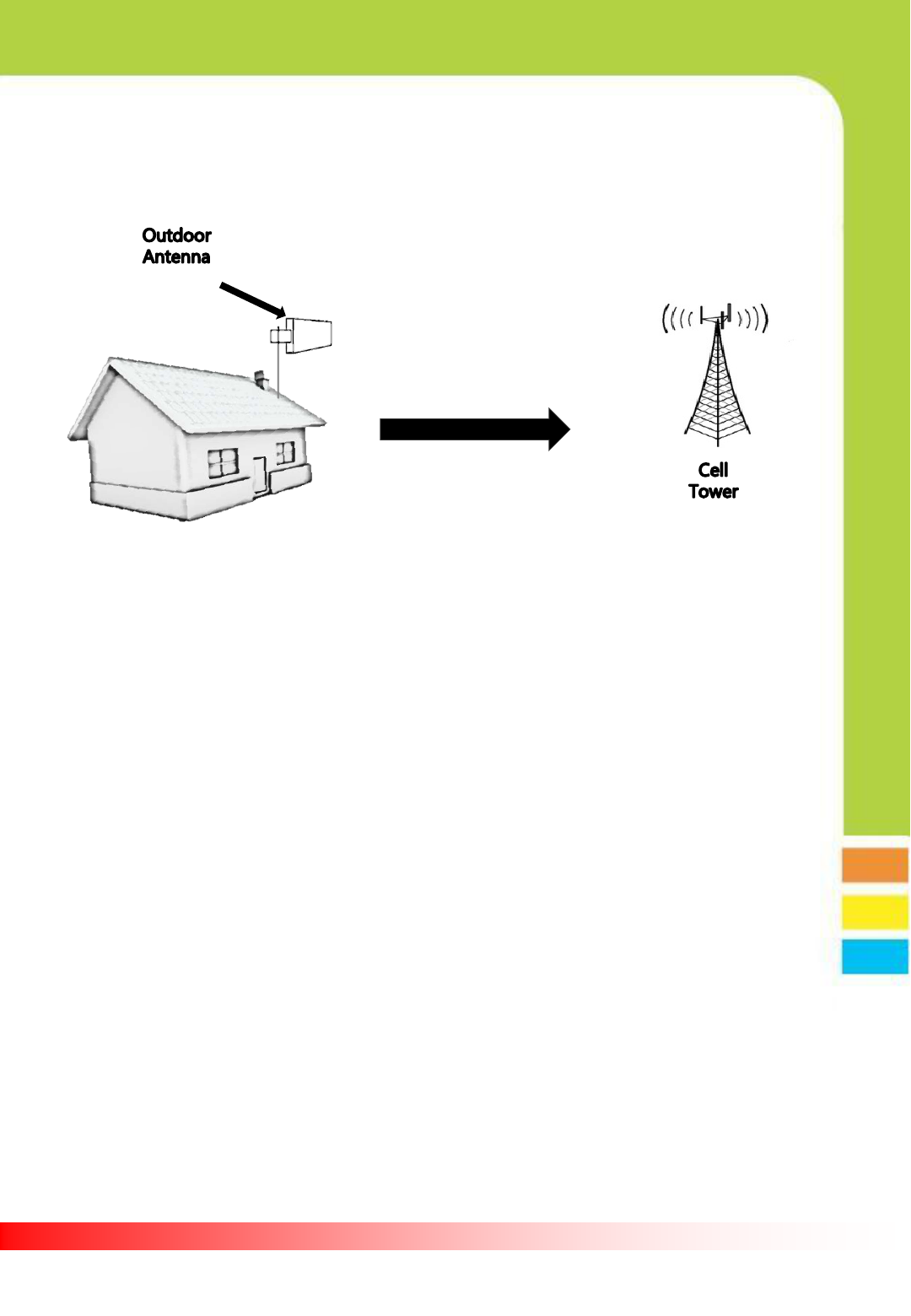
Five-band Signal Booster For In-building
3.4 Installation Details
3.4.1 Outdoor Antenna Installation
the antenna for the device must be installed to comply with the 10 meter
above ground maximum antenna height limitation .
a) Choose a location to installation where minimum heat and good
ventilation area.
b) Install outdoor antenna toward Cell Tower on the roof of building or
high area where signal reception is optimized.
c) If you don’t know where a cell tower is, install the system and find
strongest direction with your cellular phone signal and then adjust
outdoor antenna.
d) Run the cable to signal booster and connect to outdoor antenna.
e) Run the cable to indoor antenna to signal booster and choose a
location for indoor antenna.
f) Use the bracket to attach to a firm wall. A minimum distance from
indoor to outdoor antenna must be at least 20 vertical feet and 50
horizontal feet each other.
g) Turn on power as all connections are tightly finished.
h) As the green light are on, you will get better signal.
- 12 -
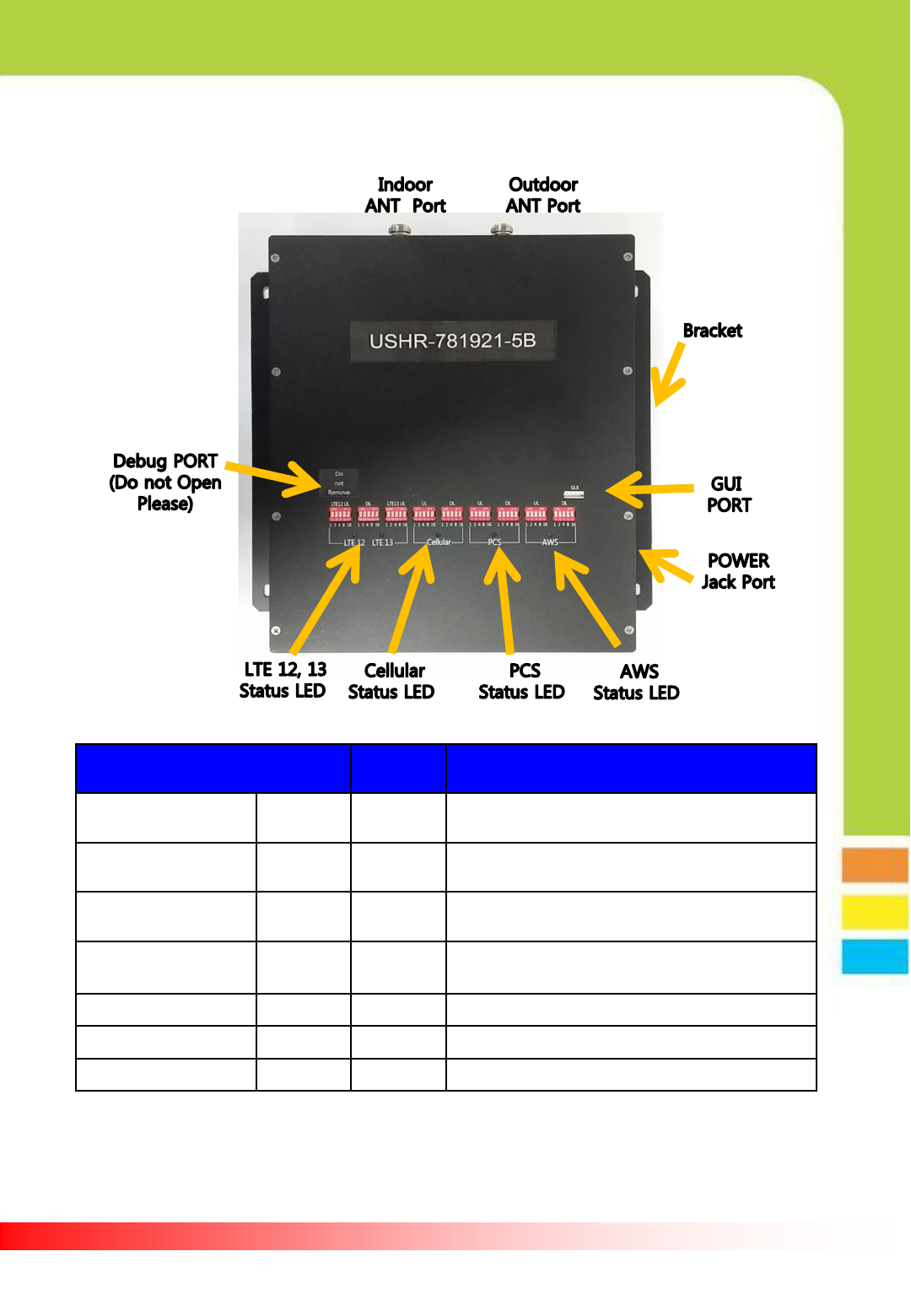
Five-band Signal Booster For In-building
3.4.2 Booster Installation
Item Q’ty Instruction
Indoor ANT Port N-Type 1 Indoor antenna connector
Outdoor ANT Port N-Type 1 Outdoor antenna connector
Bracket 4 Hole 2 Use for wall mount with 4 screws
Adaptor DC IN - 1 Adaptor for DC connection
Plug in after all connection is finished
LED Tri-color 5 See page 17
GUI Port - 1 Graphic user interface(Professional use only)
Debug Port - 1 Professional use only
- 13 -
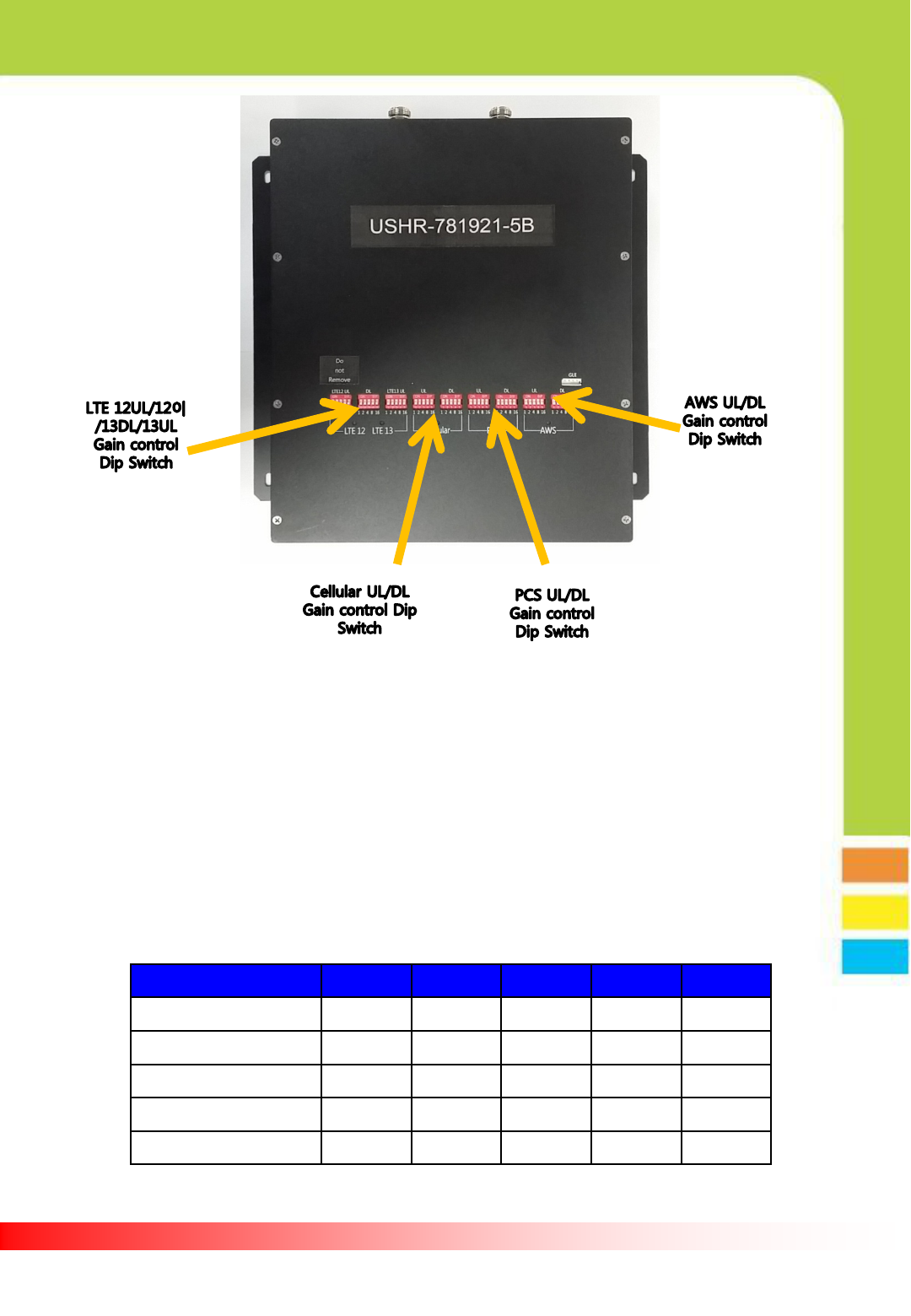
Five-band Signal Booster For In-building
① This booster designed to automatic installation function and you may
only follow instruction manual.
② Dip switch control refers the following table. In order to use dip
switch, the dip switch control function must be enabled by useing GUI
in advance. The default setting of dip switch is OFF.
③ Dip switch must be managed and operated by professional an installer
only. Please ask professional installers, distributors and dealers to
adjust dip switch.
- 14 -
Attenuation State SW1 SW2 SW4 SW8 SW16
1 dB ↑ ↓ ↓ ↓ ↓
2 dB ↓ ↑ ↓ ↓ ↓
4 dB ↓ ↓ ↑ ↓ ↓
8 dB ↓ ↓ ↓ ↑ ↓
16 dB ↓ ↓ ↓ ↓ ↑
※ Switch setting is cumulative. This means the total amount of attenuation.
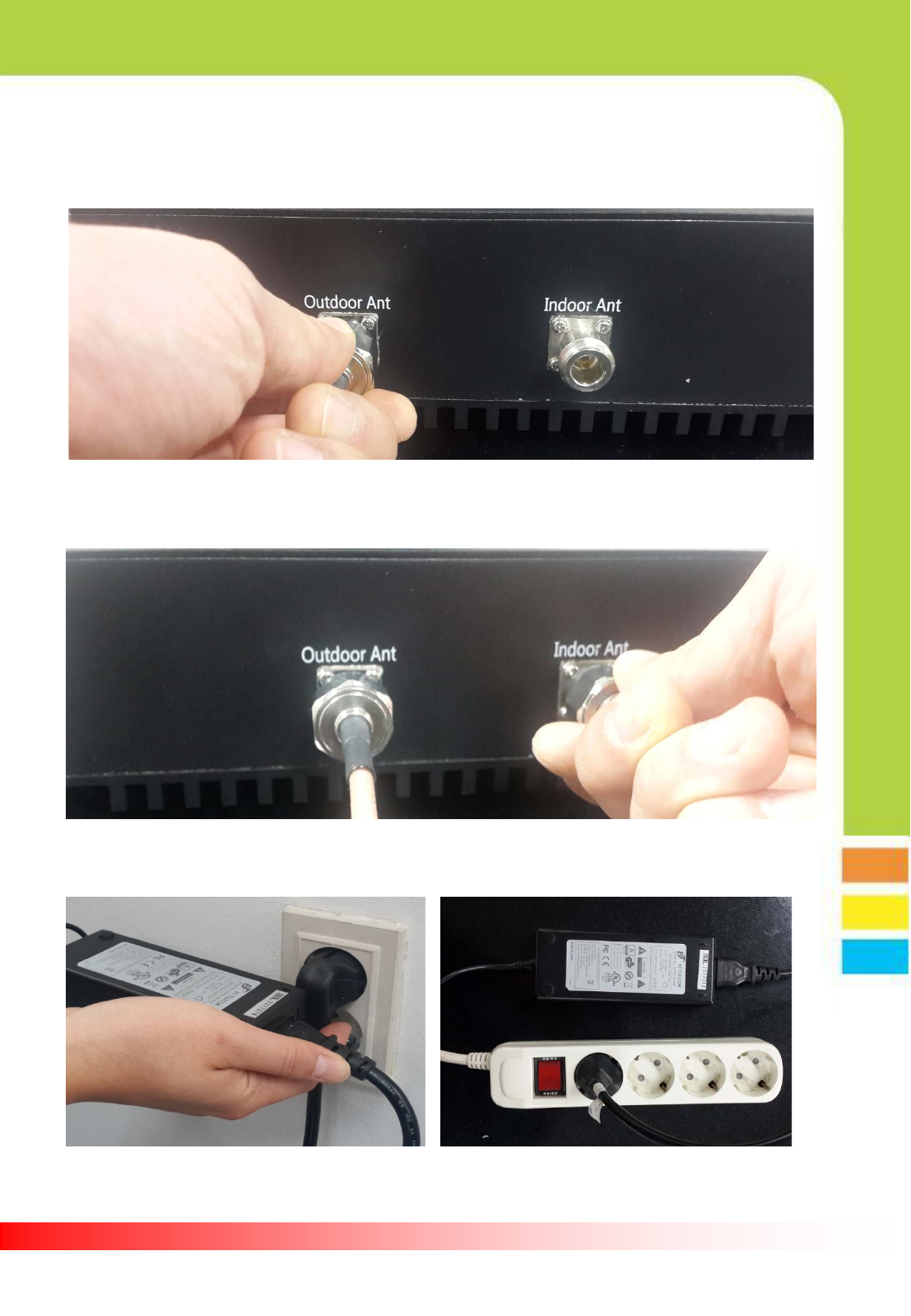
Five-band Signal Booster For In-building
3.4.3 Booster and Antenna connection
3.4.3.1. Connect donor antenna cable to outdoor antenna port as
shown below.
3.4.3.2. Connect Service antenna to indoor antenna port as shown below.
3.4.3.3. Plug in power adaptor to power outlet.
- 15 -
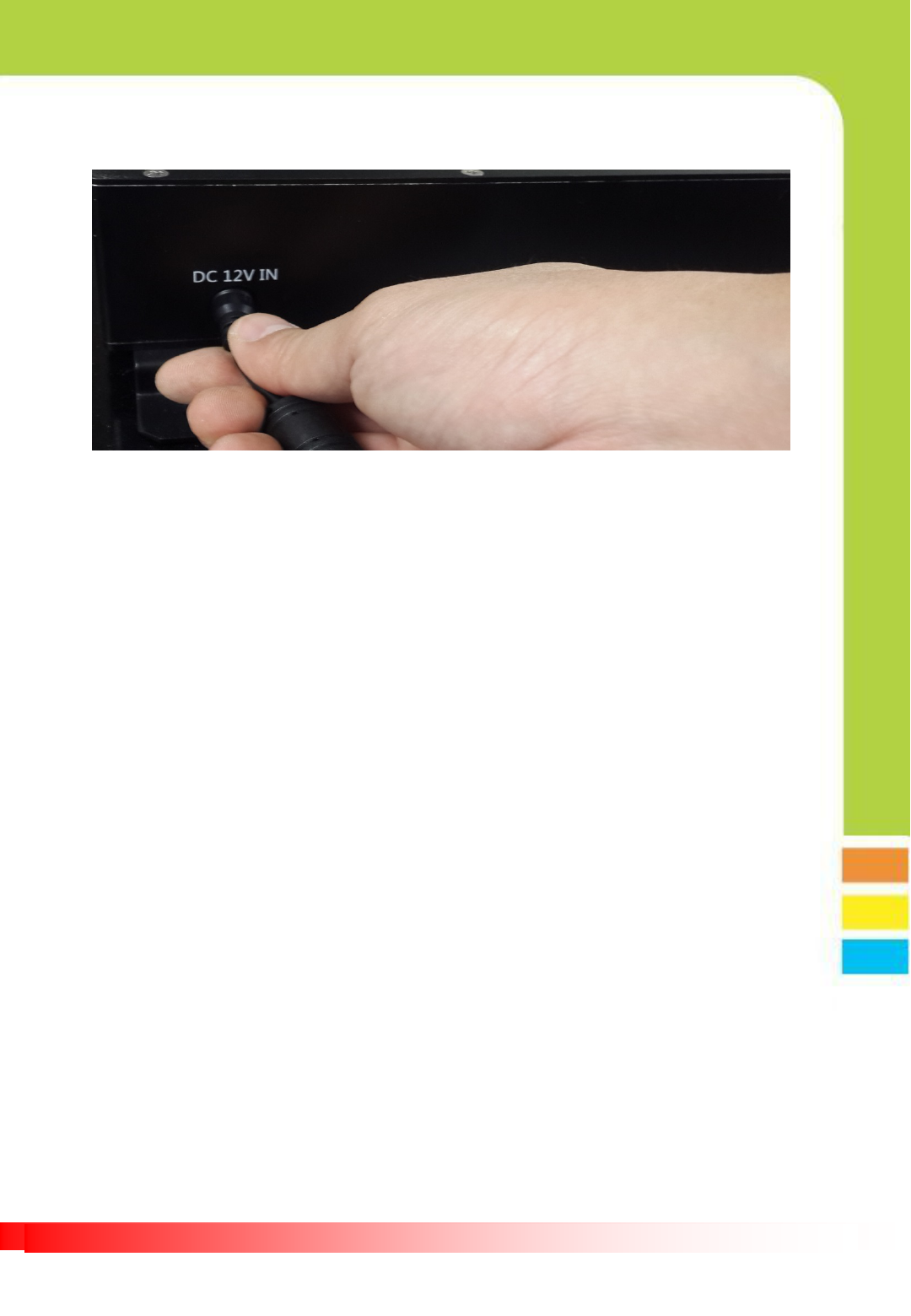
Five-band Signal Booster For In-building
3.4.3.4. Plug in AD/DC adaptor to connector listed as DC12V
3.4.3.5. The factory default set-up has both Automatic Attenuator Control &
Automatic Level Control (ALC) pre-activated by USHR-781921-5B Internal CPU.
All Isolation Check features can be manually adjusted via dip switch using GUI
program (Booster Control & Monitoring Software).
- 16 -
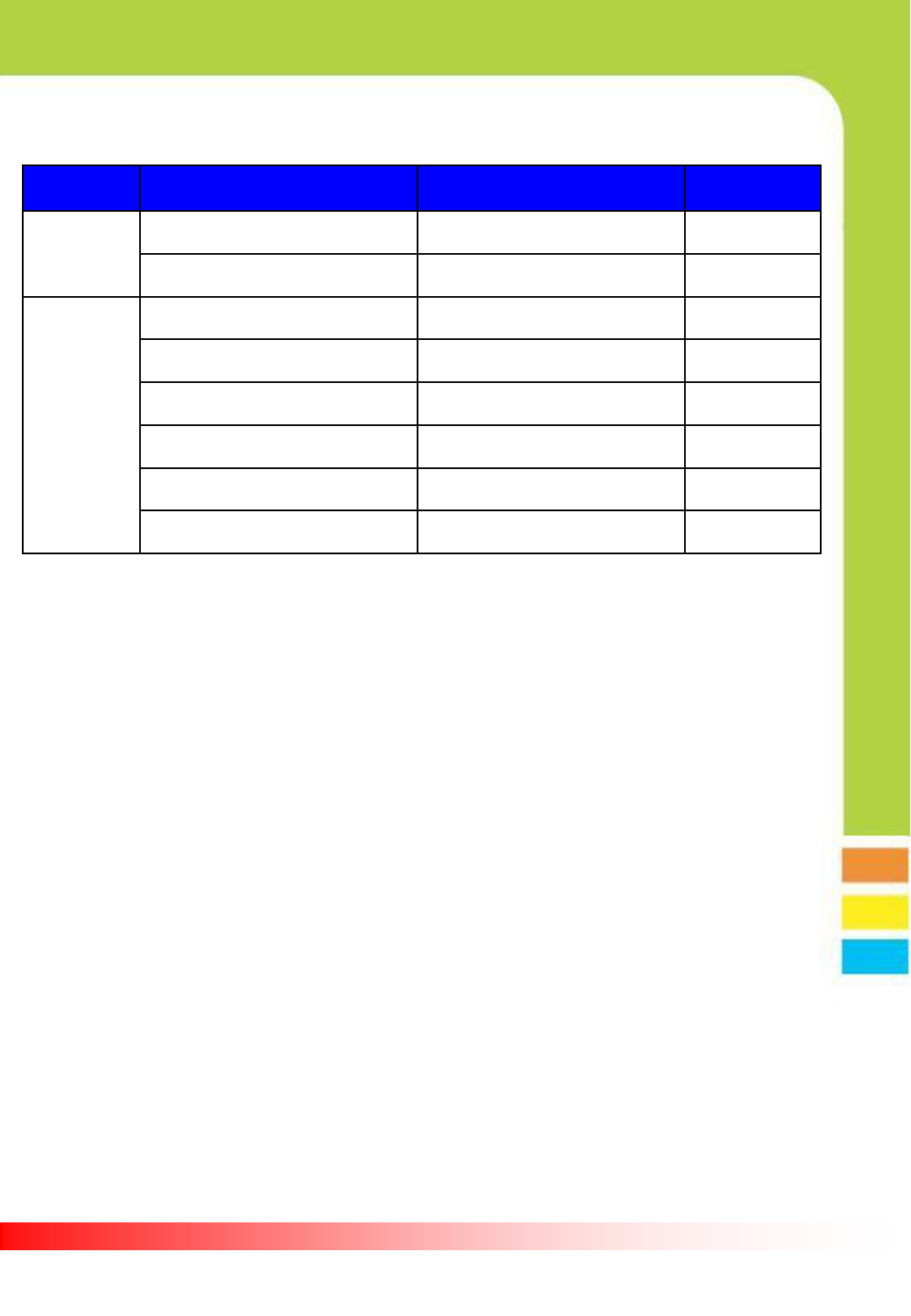
Five-band Signal Booster For In-building
4. Trouble Shooting
4.1.1. Power on /off status.
4.1.2. Normal operation condition.
4.1.3. Booster detects excessive input signal and shut down.
4.1.4 Shutdown Algorithm status on High input Signal.
4.1.5. Path OFF indicator during Uplink Sleep Mode.
4.1.6. Isolation Shutdown Algorithm status
4.1.7. Booster detects Insufficient Isolation between donor & service antenna
and shut down.
Item GREEN LED RED LED Reference
PWR
ON × See 4.1.1
OFF × See 4.1.1
ALL Band
ON - See 4.1.2
- ON See 4.1.3
Green Blinking per 1 sec cycle - See 4.1.4
Green Blinking per 5 sec cycle - See 4.1.5
- RED Blinking per 1 sec cycle See 4.1.6
RED Blinking per 5 sec cycle See 4.1.7
- 17 -
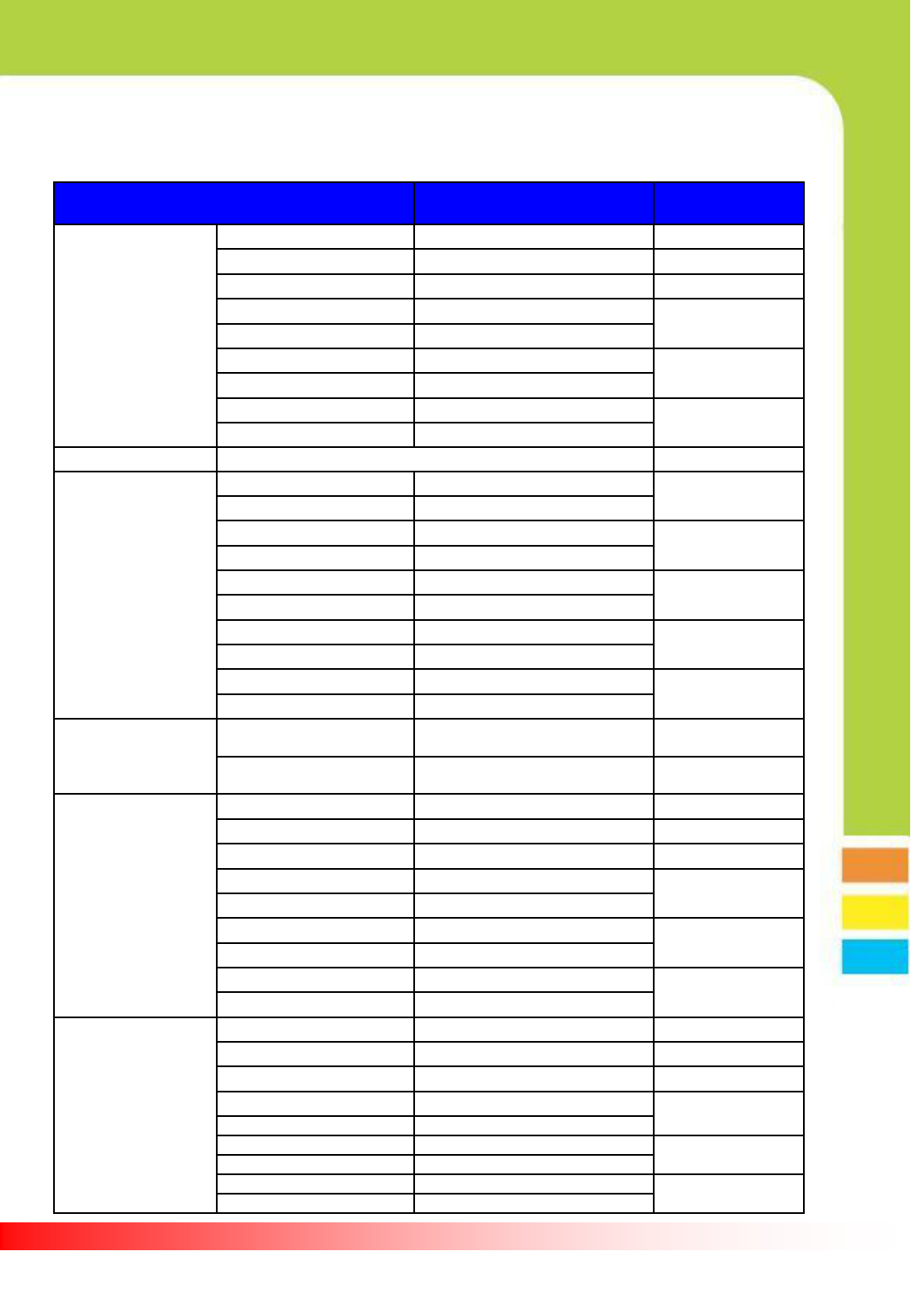
Five-band Signal Booster For In-building
5. Specifications
5.1. Electrical Specifications
Item Specifications Note
Frequency Range
Up Link 698 ~ 716 MHz BAND12
Down Link 728 MHz ~ 757MHz BAND12 / BAND13
Up Link 776 ~ 787 MHz BAND 13
Down Link 869~894 MHz BAND 5
Up Link 824 ~849 MHz
Down Link 2,110 ~ 2,155 MHz BAND 4
Up Link 1,710 ~ 1,755 MHz
Down Link 1,930 ~ 1,995 MHz BAND 25
Up Link 1,850 ~ 1,915 MHz
Modulation Type GSM. EDGE, CDMA, EVDO, HSPA, LTE
Input Power limit
Down Link -40dBm max BAND12
Up Link -10dBm max
Down Link -40dBm max BAND13
Up Link -10dBm max
Down Link -40dBm max BAND 5
Up Link -10dBm max
Down Link -40dBm max BAND 4
Up Link -17dBm max
Down Link -40dBm max BAND 25
Up Link -17dBm max
Output Power
Down Link +2dBm@ booster output port ALL DL Channel
Up Link +23dBm@ booster output port ALL UL Channel
Gain(RSSI)
Up Link 30dB ~ 60dB (±1.0dB) BAND 12
Down Link 42dB ~ 60dB (±1.0dB) BAND 12 / BAND 13
Up Link 31dB ~ 61dB (±1.0dB) BAND 13
Down Link 42dB ~ 62dB (±1.0dB) BAND 5
Up Link 31dB ~ 61dB (±1.0dB)
Down Link 42dB ~ 70dB (±1.0dB) BAND 4
Up Link 38dB ~ 68dB (±1.0dB)
Down Link 42dB ~ 69dB (±1.0dB) BAND 25
Up Link 38dB ~ 68dB (±1.0dB)
Gain(ALC)`
Up Link 33dB ~ 60dB (±1.0dB) BAND 12
Down Link 42dB ~ 60dB (±1.0dB) BAND 12 / BAND 13
Up Link 33dB ~ 61dB (±1.0dB) BAND 13
Down Link 42dB ~ 62dB (±1.0dB) BAND 5
Up Link 33dB ~ 61dB (±1.0dB)
Down Link 42dB ~ 70dB (±1.0dB) BAND 4
Up Link 40dB ~ 68dB (±1.0dB)
Down Link 42dB ~ 69dB (±1.0dB) BAND 25
Up Link 40dB ~ 68dB (±1.0dB)
- 18 -
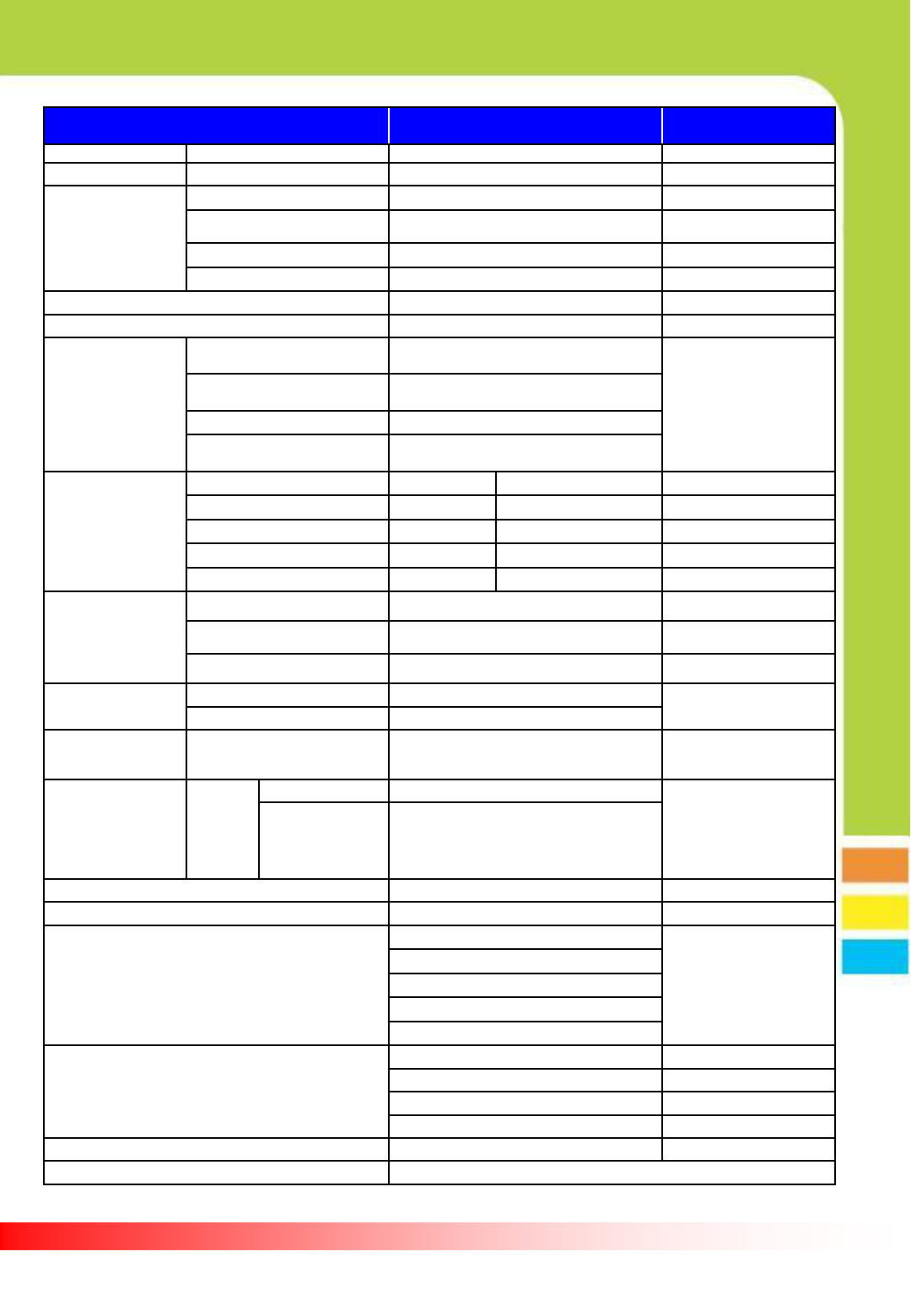
Five-band Signal Booster For In-building
Item Specifications NOTE
Ripple Down / Up Link <8dB / < 8dB(Peak to Peak)
Noise Figure Down / Up Link < 8.0dB / < 8.0dB ALL BAND Max Gain
Noise Power Limit
Down Link < -70dBm/MHz On shutdown
Up Link < -70dBm/MHz On shutdown & sleep mo
de
Down / Up Link FCC ALL BAND
Down / Up Link FCC ALL BAND
Propagation Delay < 3us
Input VSWR ≤ 2.0 : 1
ALC Setting Level
Down Link(Upper Value) +2dBm±1.0dB
Window Size(Lower Offset) 1 ~ 10dB(Default : 2dB)
Up Link (Upper Value) +23dBm±1.0dB
Window Size(Lower Offset) 1 ~ 10dB(Default : 2dB)
ALC Range
Down / Up Link DL ≤ 18dB UL ≤ 27dB Band 12
Down / Up Link DL ≤ 18dB UL ≤ 28dB BAND 13
Down / Up Link DL ≤ 20dB UL ≤ 28dB BAND 5
Down / Up Link DL ≤ 28dB UL ≤ 28dB BAND 4
Down / Up Link DL ≤ 27dB UL ≤ 28dB BAND 25
Shutdown Level
Down Link ≥-40dBm/Total±1.0dB ALL Down Link
Up Link ≥-10dBm/Total±1.0dB Band12, Band13, Band 5
Up Link ≥-17dBm/Total±1.0dB Band 4, Band 25
OSC Level Down Link DL detects OSC under 1 sec.
Up Link UL detects OSC under 0.3 sec.
Uplink In-activity Up link On@ > -88dBm, OFF@ < -90dBm -No uplink signal for
5 minutes
Gain Control
Range
Dip Swit
ch
Down link 0dB ~ 30dB / 1dB Step -Be controlled GUI
or Dip Switch
-Total Atten Control
Range : 0dB ~ 30dB
/ 1dB Step
Up link 0dB ~ 30dB / 1dB Step
Gain Control Deviation < ± 1dB
EVM < 7% No Feedback
Isolation checking Range
30dB ~ 75dB / BAND12
Detecting deviation: < ±2
.0dB
31dB ~ 76dB / BAND13
31dB ~ 76dB / BAND 5
38dB ~ 83dB / BAND 4
38dB ~ 83dB / BAND 25
Out Band Spurious
< -13dBm/1kHz RBW 9kHz ~ 150kHz
< -13dBm/10kHz RBW 150kHz ~ 30MHz
< -13dBm/100kHz RBW 30MHz ~ 1GHz
< -13dBm/1MHz RBW 1GHz ~ 12.75GHz
3rd IMD Level < -19dBm Max Output Level
Frequency Stability ≤ ±0.01ppm
- 19 -
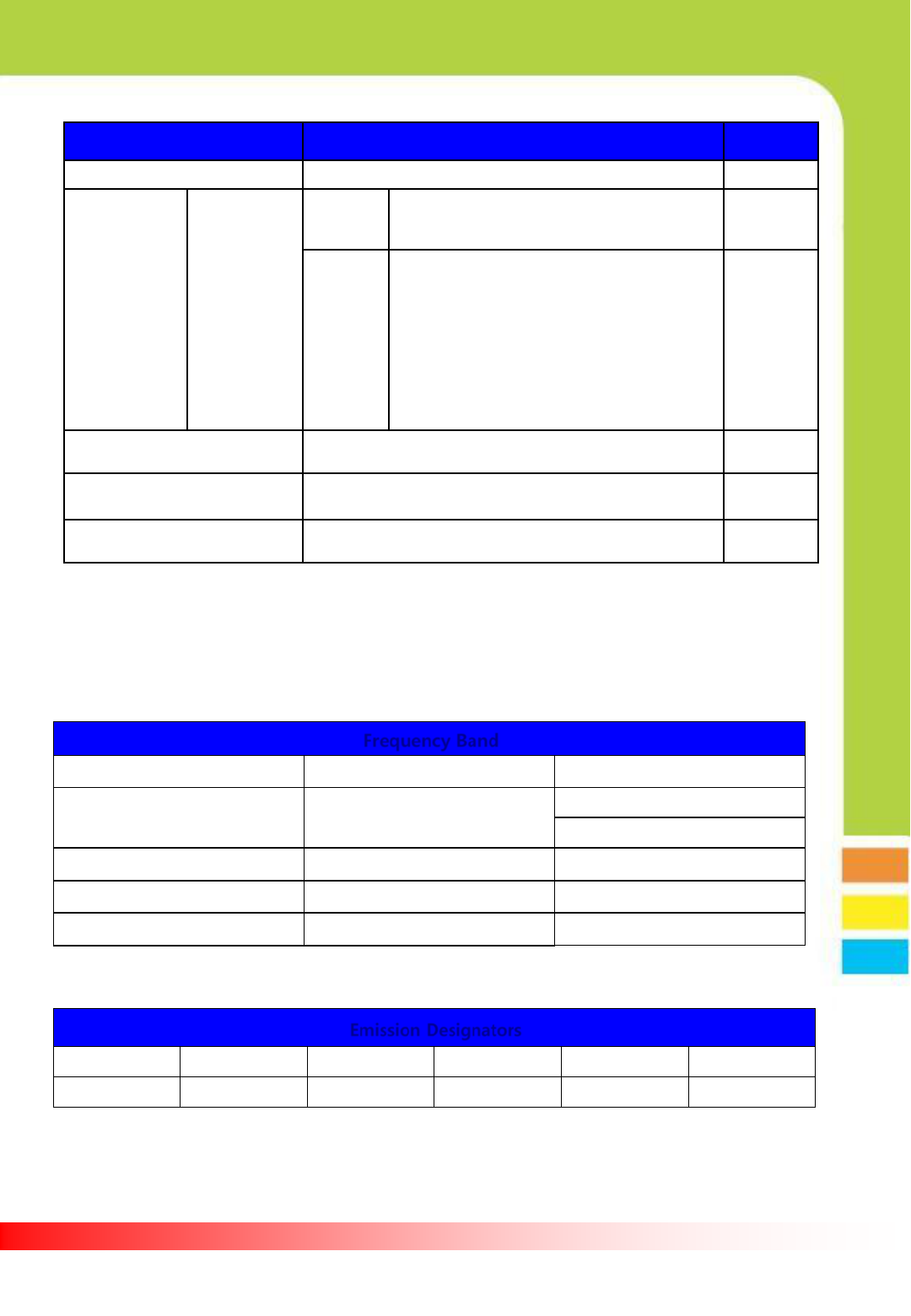
Five-band Signal Booster For In-building
ITEM Specifications NOTE
GUI Interface RS-232C
Alarm & Status Display
PWR ▪ Normal: Green
▪ Power turn off: Off
Alarm
▪ Normal: Green
▪ Over Power Shutdown: RED
▪ Checking SD: Green Blinking per 1 sec cycle
▪ Checking OSC Algorithm: Red Blinking per
1 sec cycle
▪ Sleep Mode: Green Blinking per 5 sec cycle
▪ Isolation SD : RED Blinking per 5 sec cycle
Power Consumption < 50W
Operating Power AC/DC Adapter (AC110V or AC220V)
RF Connector N-type Female
- 20 -
● Additional Information:
This booster is a bi-directional amplifier for the boosting of cellular phone signals
and data communication devices.
The following frequency bands and emission types are utilized.
Frequency Band
Band DL UL
Band 12 & Band 13 728 ~ 757 MHz 698 ~ 716 MHz
776 ~ 787 MHz
Band 5 869 ~ 894 MHz 824 ~ 849 MHz
Band 4 2110 ~ 2155 MHz 1710 ~ 1755 MHz
Band 25 1930 ~ 1995 MHz 1850 ~ 1915 MHz
Emission Designators
CDMA HSPA LTE EVDO EDGE GSM
F9W F9W G7D F9W G7W GXW
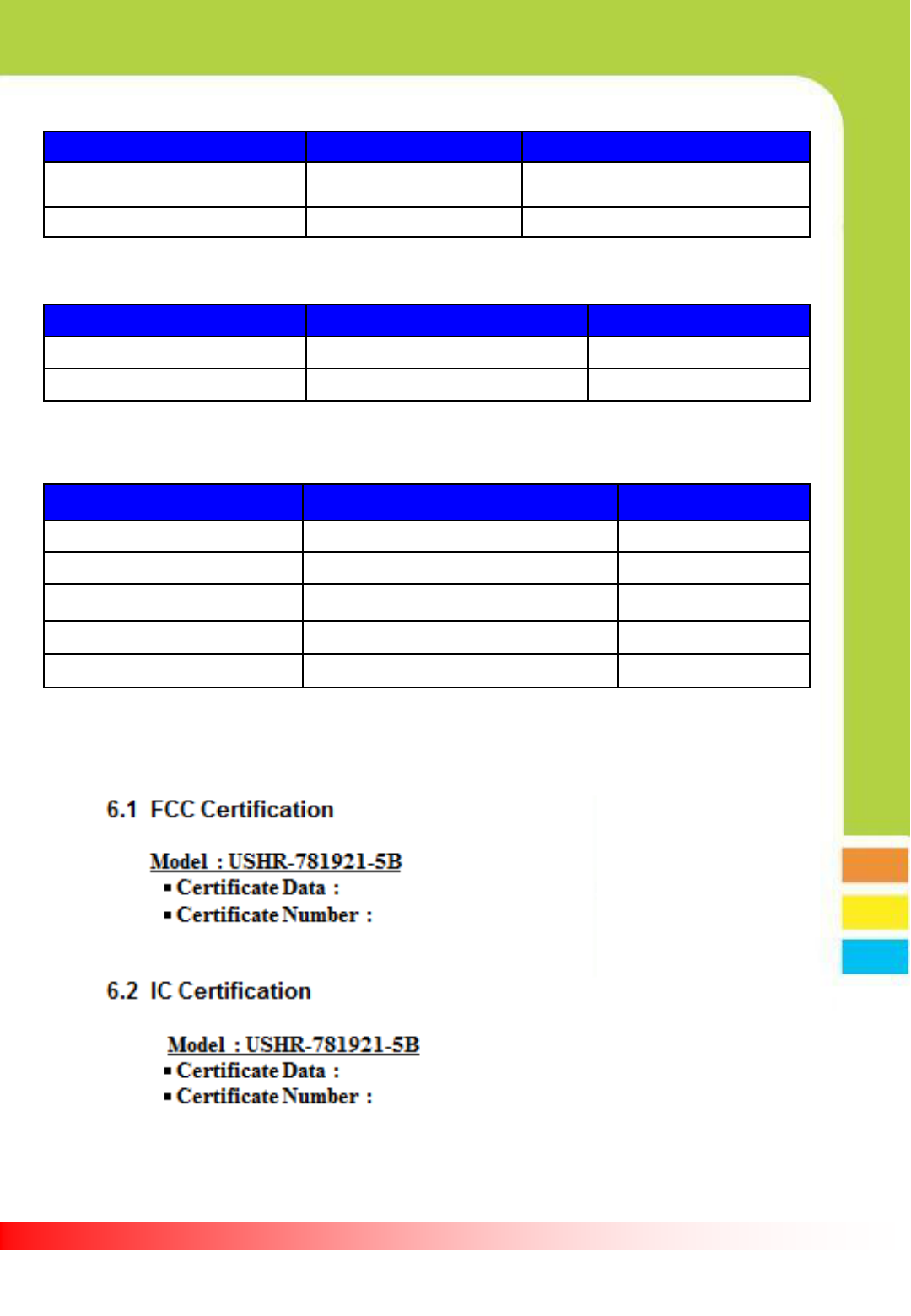
Five-band Signal Booster For In-building
Item Specifications Note
Dimensions (L × W × H) 231mm x 288mm x 71mm Except Bracket and Connector
(Tolerance ±5mm)
Weight < 6.8Kg
Item Specifications Note
Temperature -30 ~ 55℃ (-22 ~ 131℉)
Humidity 10 ~ 95%
5.2. Mechanical Specification
5.3. Environment Specification
Items Specifications Note
AC input power 90VAC ~ 264VAC, 47Hz ~ 63Hz
Output Voltage +12.0 VDC
Current Range 6.0A ~ 0.0 A
Operation Temperature -30℃ ~ +55℃
Operation humidity 10% ~ 90%
5.4. AC/DC Adaptor Specification
6. Certificates
- 21 -
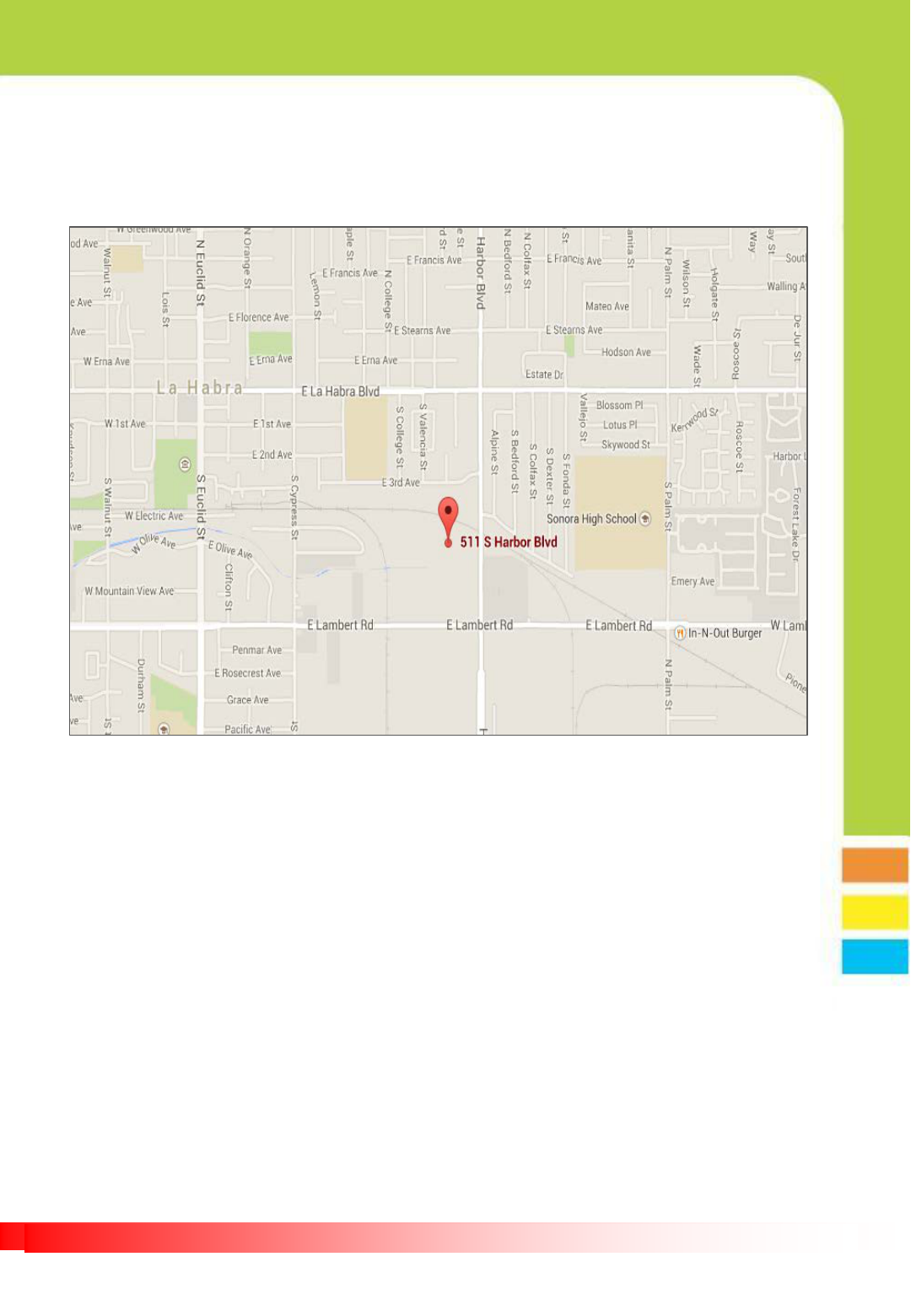
Five-band Signal Booster For In-building
7. Contact Information
7.1 Location
7.2 Contact
Address : 511 s. HARBOR BLVD STEP. LAHABRA, CA 90631
Mon.-Fri. Hours : 9 a.m. to 5 p.m.
TEL : 562-448-3102
FAX : 562-448-3105
- 22 -
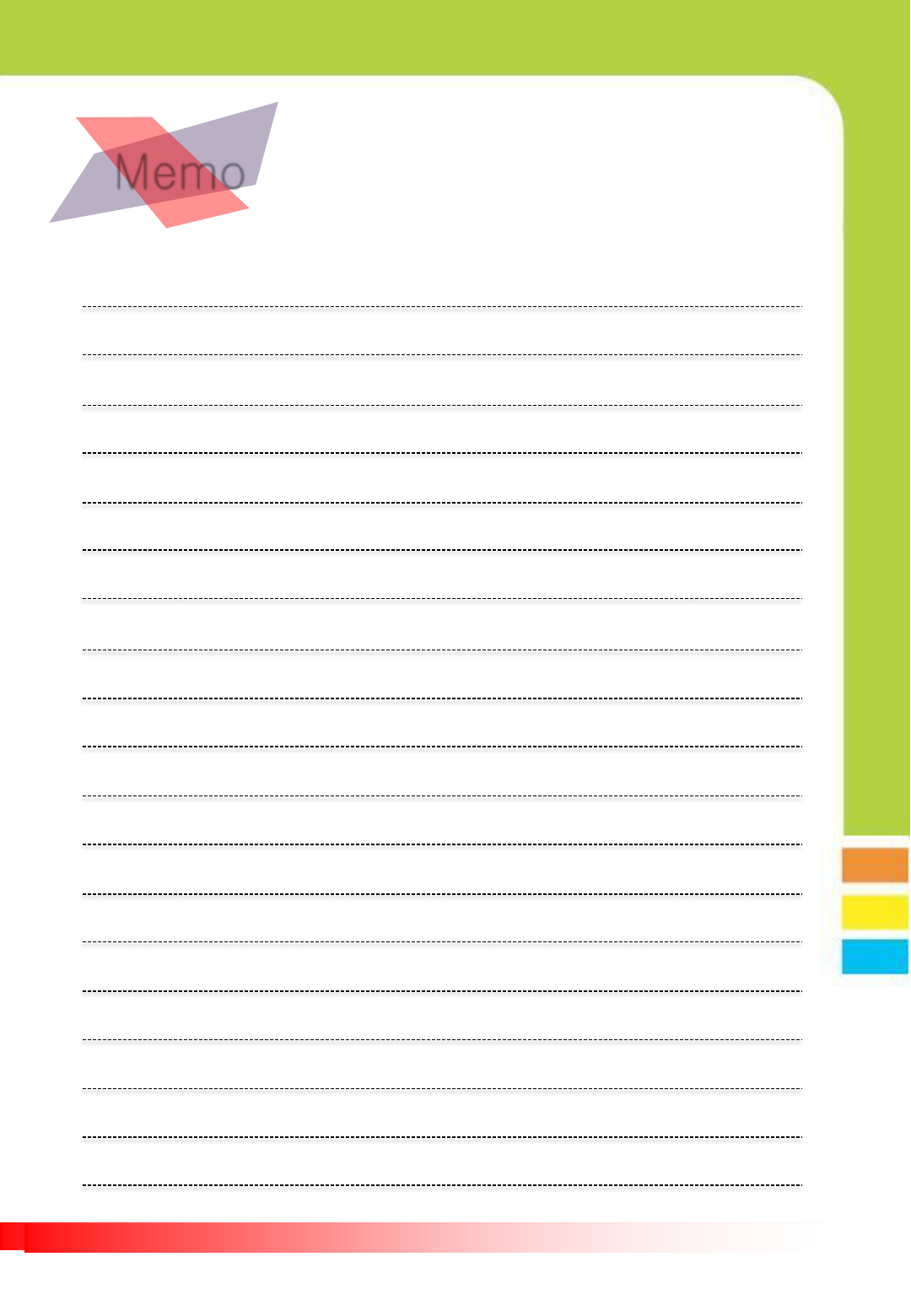
Five-band Signal Booster For In-building
- 23 -
Memo